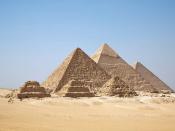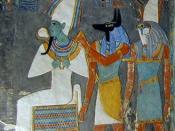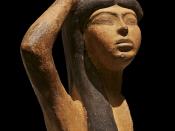Osiris, as the god of death, vegetation and fertility, became an increasingly prominent figure in the lives of the Egyptian people and became core to their concepts of immortality and life after death. Osiris was depicted in human form clad in mummies wrappings. The fact that he takes human form allows the Egyptian people to identify with him much more easily, thus allowing the supposed transformation into him more readily accepted. The mummy's wrappings are a result of his death and eventual resurrection. He also holds a crook and flail symbolizing power and was often depicted with green skin, alluding to his role as a god of vegetation.
As a deity Osiris was originally very passive and of relatively little importance. It was even believed he wasn't even able to speak out for himself against the other god's until the 9th or 10th dynasty. However, as burials and funeral rites became paramount in Egyptian culture, he naturally became the supreme god of Egypt.
It is evident that as he became a more and more celebrated figure (as generations passed, different Gods became more or less popular) he began to absorb the attributes of the less important deities. It is because of the huge emphasis and belief in life after death and Osiris's rule over it that compounded his importance. They believed that if the body was preserved in a mummified state with enough food and equipment to survive, and providing they had lived a good and honorable life, they would live forever in the underworld.
By the 18th dynasty he had become so powerful and popular that he was the equal of Ra the sun god, this is evident in the transformation in the spelling of his name in the late dynastic period. The original spelling was a "throne"...


